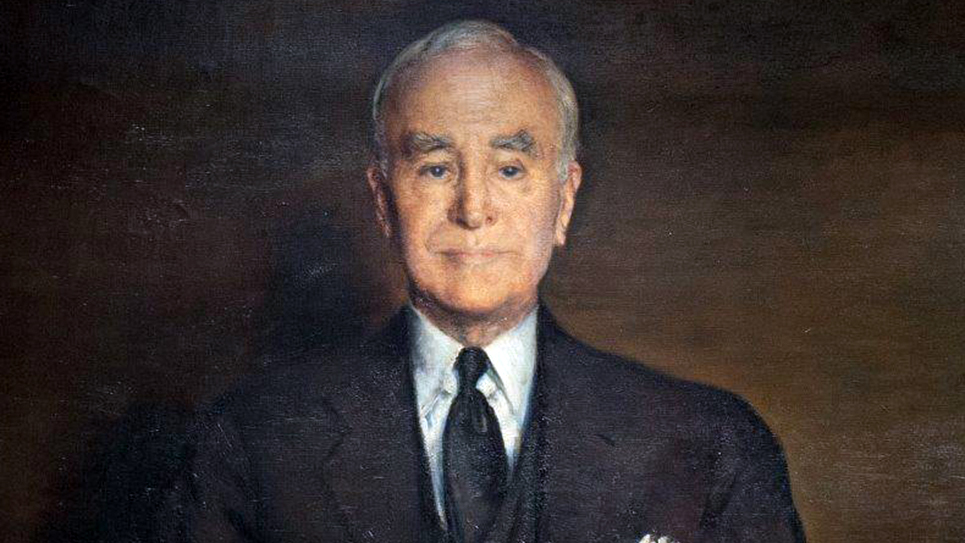Matriarch of the Living Wage: Mary Teresa Norton of New Jersey
The first woman ever elected to the U.S. House of Representatives was Jeanette Rankin of Montana, a Republican. Miss Rankin was first elected in 1916. The first woman elected to the House as a Democrat was Mary Teresa Norton of New Jersey. Unlike many of her colleagues, she did not come to the House as the widow of a husband who had preceded her; Mrs. Norton had won election to the House of Representatives in her own right. Indeed, as her biographer noted, no male member of her family had any connection to politics. Born the daughter of immigrants from Ireland, Mary Teresa Norton became a trailblazer for her gender and a productive legislator and leader.
Mrs. Norton was the first congresswoman elected from the eastern part of the United States. TIME magazine once described Congresswoman Mary Teresa Norton as “a large, brown-eyed Roman Catholic, a onetime social worker and since 1920 a wheelmare for New Jersey’s Democratic Boss Frank Hague.” Because of her interest in labor issues and dedication to her working-class district, biographer Lisa Kutlin appropriately christened Congresswoman Mary T. Norton as the “Matriarch of the Living Wage.” Kutlin’s biography quoted from a manuscript of Mary T. Norton’s unpublished autobiography.
A career in politics is never without its peculiar challenges, but Mary T. Norton faced challenges in the context of the time in which she lived that have faded in today’s world.
During her 25 years in the House of Representatives, Mary T. Norton was a staunch supporter of Franklin Roosevelt’s New Deal, a strong advocate for the rights of women, and a friend to working people and labor. Mrs. Norton’s own parents had been working-class people; her father had worked for the railroad, as well as in construction. Norton’s mother, Marie Shea Hopkins, had been a governess before marrying her husband, Thomas. The Hopkins family lived on the second floor of a three-story home while renting out the other two floors to pay the mortgage. Mary T. Norton’s formal education ended at age twelve, a fact she did her best to hide throughout her career. Much of Mary T. Norton’s life was molded by the early loss of an elder brother she idealized and that of her only child, who died in infancy. “When my only child, a son, died in infancy, the bottom dropped out of my world for a time.”
Mary Teresa Norton got to Congress by working her way up through the political ranks and represented Hudson County as a member of the New Jersey Democratic State Committee in 1920. From 1921-1932, Mrs. Norton served as the vice chair of that committee. Mrs. Norton’s electoral career began with her election to the Board of Freeholders for Hudson County in 1922. Two years later, Mary T. Norton was elected to the House of Representatives from Hudson County. In truth, Mrs. Norton was the product of one of the most notorious political machines in the country. Mary T. Norton was the congressional emissary of Boss Frank Hague, who was the political master of Hudson County, New Jersey. Of course, many members of Congress have had strong ties to political machines, not the least of which was Harry Truman. Like Harry Truman, Mary T. Norton bristled at the notion she was merely a creature of the Hague machine. Mrs. Norton well understood Boss Hague needed her as much as she needed him, if not more. Hague had promoted Mary T. Norton when women first got the vote. Hague, like Ed Crump in Memphis, realized the political necessity in drawing female voters into his machine. Perhaps because of her gender, throughout her time in Congress, Mary T. Norton worked especially hard to justify the confidence the people of her district had placed in her. It was a thought that was omnipresent in her mind. Certainly, as the first woman elected to Congress as a Democrat, Mary T. Norton had something to prove. Norton had first been elected in what was considered a “Republican” year. In fact, Republicans had done very well in Hudson County, but Mary T. Norton had won decisively over her GOP opponent. The truth is, Mary Teresa Norton was much like the great majority of the people she represented, being from a working-class background and a Catholic.
Lisa Kutlin illustrated Mary T. Norton’s ability to handle a hostile audience by recounting the future congresswomen attending a meeting where she was to speak to what she thought would be a group of women. Mrs. Norton was surprised to find a sullen group of men awaiting her. “Where are your women?” Mrs. Norton wondered. “This was supposed to be a meeting for women.” One fellow stood up and said, “Our women are home, looking after their children – – – where you ought to be.” Mary T. Norton acknowledged in her unpublished autobiography that she initially “really saw red for an instant.” Taking a breath, Mrs. Norton replied with dignity, “How very, very fortunate they are to have children! [T]hat privilege has been denied me. If I had children, I’d certainly be at home with them now if they needed me. But since I haven’t, I am here to talk to you about a new responsibility that has been given women.” Her response caused the man to rise after her talk and apologize for his earlier comments.
Mrs. Norton readily acknowledged that she paid very close attention to the Democratic leaders of her district. “I always take the recommendation of county leaders as to the fitness of a man or woman for a job,” she said.
As to being one of the few women elected to the House, Mrs. Norton revealed her formula for getting along with her male colleagues. “Don’t disagree with men unless it’s necessary. You can have your own way without antagonizing them.”
Nor was Mrs. Norton a mere decoration in Congress. Her matronly appearance disguised a quite savvy politician who knew the ins and outs of the legislative process and understood how to jab an elbow into the ribs of political opponents. Mary T. Norton was quite popular in her own right, tending to the needs and problems of her constituents. Mrs. Norton’s warm personality and thoughtfulness was much appreciated by those who knew her. One such example of those qualities occurred during a memorial service for the seven members of Congress who had died in 1935, which included Senator Huey Long. As the House clerk read the biography for the late Senator Long, Mary T. Norton took an American Beauty rose and quietly placed it in a vase in memory of the late Louisiana senator. As the roll call of the dead was read, one by one, Mary T. Norton placed a rose in a vase for each fallen member.
Mrs. Norton’s matronly exterior masked a steely determination that became readily apparent when the occasion demanded it. It was Mary T. Norton who successfully went around John J. O’Connor, the chairman of the powerful House Rules Committee. When President Roosevelt’s Wage & Hours Bill got stuck in the Rules Committee, it was Mary T. Norton who carried a petition and convinced 216 of her colleagues to sign and discharge the legislation to bring it to the House floor. Mary T. Norton had been the first congresswoman ever to chair a committee of the House when she assumed the chair of the House District of Columbia Committee. Mrs. Norton’s chairmanship of the House Labor Committee was important to the people of her working-class district and made her invulnerable in an already safe seat. Mrs. Norton was the first woman to chair a major committee in the House of Representatives.
That same tenacity of purpose won New Jersey its first veterans’ hospital. Assigned to the Veterans Affairs Committee, Mary T. Norton assiduously pushed for a veteran’s hospital for her state. Under consideration by the committee was a veterans’ hospital in Pennsylvania. Mrs. Norton noted Pennsylvania already had two veterans’ hospitals while New Jersey had none. The congresswoman made a motion to build and operate a veterans’ hospital in New Jersey by splitting $3.5 million between her state and that of Pennsylvania. To the surprise of quite nearly everyone, Mrs. Norton’s motion passed. To the fury of Congresswoman Norton, the committee report apparently did not mention anything about her motion or building a veterans’ hospital in New Jersey. Insisting she be allowed to read the committee report, Mrs. Norton’s worst fears were confirmed; the report did not contain any mention of her motion, nor the fact that motion had carried or the building of a veterans’ hospital in New Jersey. Congresswoman Norton approached every member of New Jersey’s House delegation, most of them Republicans, and organized them all in support of a veterans’ hospital for their state. The Veterans Affairs Committee met, and a furious Mary T. Norton demanded the committee members acknowledge her motion and the fact it had carried almost unanimously. After an awkward silence, a congressman from Pennsylvania confessed he recalled Mrs. Norton’s motion. Mary T. Norton made her motion once again and it passed yet again. Because of Mary Teresa Norton’s persistence and determination, New Jersey finally got its own veterans’ hospital.
In 1937, Mary T. Norton, then 62 years old, was elevated to the chairmanship of the House Labor Committee, one of the busiest committees in the House of Representatives. Mary T. Norton was instrumental in passing the Fair Labor Standards Act the following year. “I am prouder of getting that bill through the house than anything else I’ve done in my life,” Congresswoman Norton said. Yet her ascension to the chairmanship of the House Labor Committee did not come easily even though she had the seniority to make her the chair. The speaker of the House, William Bankhead of Alabama, urged her to remain as chair of the relatively minor District of Columbia Committee. Southern Democrats especially preferred Georgia’s Robert Ramspeck to chair the House Labor Committee. The Southerners had issues with some aspects of the Fair Labor Standards Act and Congressman Ramspeck was sponsoring his own version of the bill, which was far more palatable to Southern congressmen. The opposition was formidable, a coalition of Republicans and Southern Democrats were opposed to the bill desired by President Roosevelt. Mary T. Norton insisted upon her seniority rights and by those rights, she was entitled to chair the House Labor Committee. Congresswoman Norton was able to navigate between various factions, including Mayor Frank Hague who was frequently anti-labor.
As might be expected of a congresswoman who represented a working-class district, Mary T. Norton was a firm friend of organized labor. While Congresswoman Norton strongly supported equal pay for equal work, she was opposed to the Equal Rights Amendment. When Mary T. Norton asked to be sent as a delegate to the first meeting of the United Nations in San Francisco in 1945, President Truman instead appointed the congresswoman as an alternate delegate to the International Labor Organizing Conference meeting in Paris.
Throughout her tenure in Congress, Mary T. Norton used her seniority and committee assignments to see to it that her congressional district received its fair share of public favors and projects, which always brought much-needed jobs and money to her people.
When Republicans won control of both houses of Congress in 1946, the mirror opposite of Mary T. Norton assumed the chairmanship of the House Labor Committee. Fred A. Hartley, one of the authors of the Taft-Hartley Act, was also a congressman from New Jersey, albeit a conservative and a Republican. Congresswoman Norton was as strongly against the Taft-Hartley bill as Hartley was for it. Mary T. Norton refused to further serve on the committee and resigned her spot on the Labor Committee.
Mary T. Norton voluntarily retired from Congress in 1950, choosing not to run again at age 75. In 1953, Norton resigned as New Jersey’s Democratic National Committeewoman. “When a woman gets to be 78 years old, she has reached a time when she should retire,” Mrs. Norton said.
The former congresswoman lived quietly until her death in Greenwich, Connecticut, in 1959.
© 2024 Ray Hill







